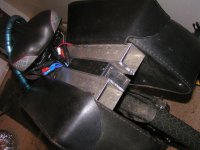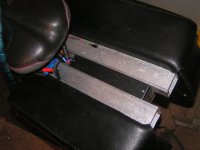Ohbse
10 kW
John in CR said:Allex said:John, are you saying that I should accept slow acceleration
Wrong! Misconceptions and following others who never took the time to properly tune their systems and understand what the different settings actually do will keep you from getting the most out of your system. Let's assume the battery current displayed in your video is correct. Then drawing 11kw from the battery at 5kph is creating tons of extra heat in the system that isn't necessary to create the torque you feel. I don't have an Adaptto, so maybe it requires a different ratio since we already know that the 400A isn't real and can never be real with only 11kw coming out of the battery.
John - I think you might have a misconception of your own there.. of course 11kw coming out of the battery is incorrect because that 400a is not at battery voltage. At very low speed the voltage the motor is seeing could be a mere 10v and 400a. The defined phase current on the adaptto is correct - each phase has current measurement baked in. There's no reason to believe 400a is not possible, I strongly suspect your setup would briefly pull similar currents at low speed. Despite the configured phase current the older 'infineon' controllers are notorious for massive overshoots at low speed. People moving to Adaptto controllers have often lamented the lack of 'punch' at low speed relative to their older controllers. This is because the Adaptto is *actually* delivering the current you set - not near limitless for the first fraction of a second. As you've touched on, you can get away with that on a low power setup, but not so much at motorcycle levels of power.
You're absolutely correct regarding high current efficiency. Endlessly bumping battery current in pursuit of performance is a recipe for compounding heat issues and disappointment. That said, running a very high level of phase current at low speed doesn't always have to lead to huge heat issues. It really depends on route and riding style. Just because I have my adaptto settings turned up doesn't mean every time I tweak the throttle it's going to hit it with a burst of current, it will only deliver what you ask for - this is another key difference between these controllers and the older style.
I have found that there's an upper limit of usable phase current, in my case it's the point where even with all my weight shifts forward I end up looking at the sky. For my short wheel base DH Comp this point is about 240 phase amps. This is pretty easily calculable with the weight, weight distribution and centre of gravity estimation for the vehicle and the torque constant of the motor, temperature of the windings and size of the rolling stock. In my case the adaptto defined current pretty closely aligns with the calculations I put together to calculate wheelie point. FYI I run an 80amp battery limit most of the time. 6.5kw is enough to hit the speeds I desire and ~200 phase amps is enough to get there quickly with no heat issues at all. Bike and me weigh 112kg with gear on. With more mass, longer wheelbase or a more front focused weight distribution I could use more phase current.



